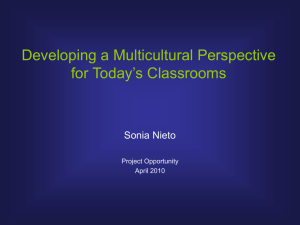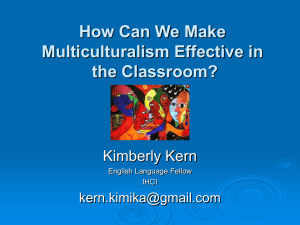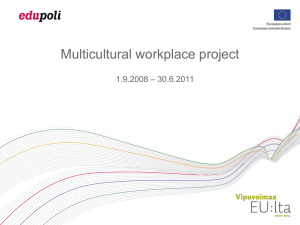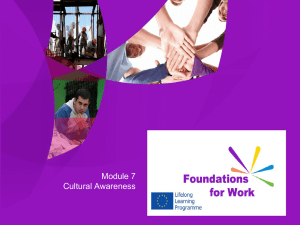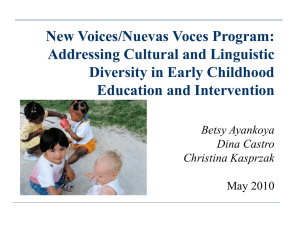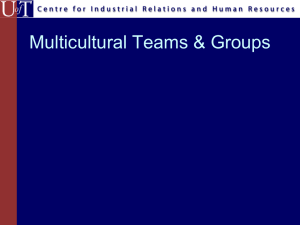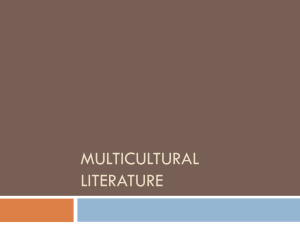ohr_asset_097640
advertisement
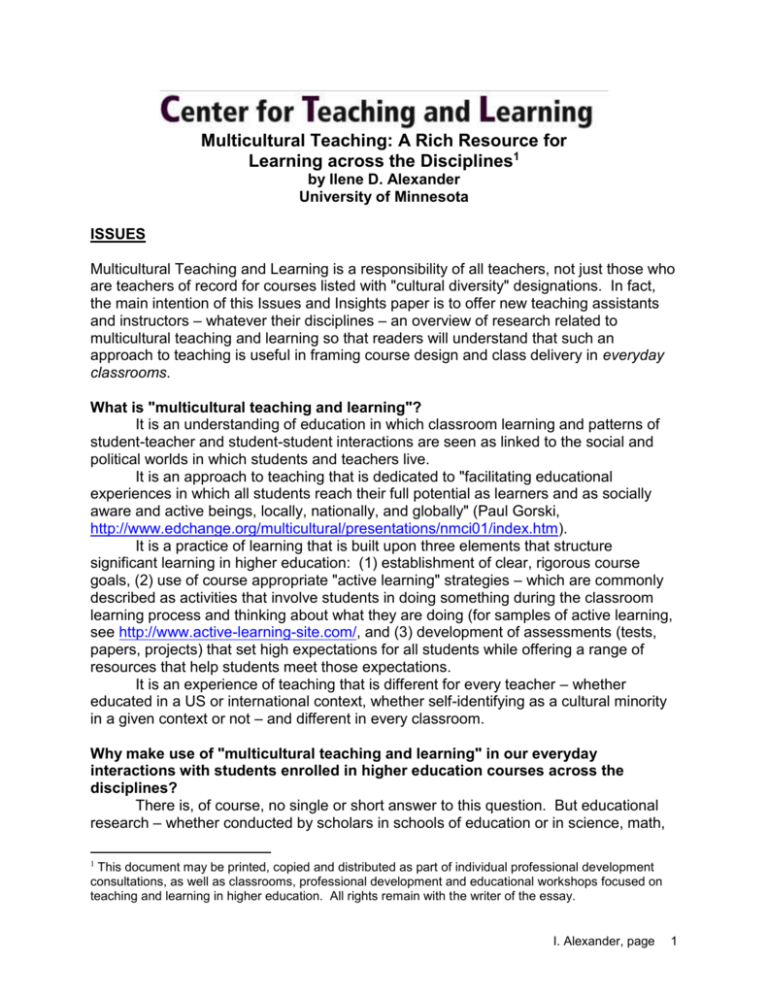
Multicultural Teaching: A Rich Resource for Learning across the Disciplines1 by Ilene D. Alexander University of Minnesota ISSUES Multicultural Teaching and Learning is a responsibility of all teachers, not just those who are teachers of record for courses listed with "cultural diversity" designations. In fact, the main intention of this Issues and Insights paper is to offer new teaching assistants and instructors – whatever their disciplines – an overview of research related to multicultural teaching and learning so that readers will understand that such an approach to teaching is useful in framing course design and class delivery in everyday classrooms. What is "multicultural teaching and learning"? It is an understanding of education in which classroom learning and patterns of student-teacher and student-student interactions are seen as linked to the social and political worlds in which students and teachers live. It is an approach to teaching that is dedicated to "facilitating educational experiences in which all students reach their full potential as learners and as socially aware and active beings, locally, nationally, and globally" (Paul Gorski, http://www.edchange.org/multicultural/presentations/nmci01/index.htm). It is a practice of learning that is built upon three elements that structure significant learning in higher education: (1) establishment of clear, rigorous course goals, (2) use of course appropriate "active learning" strategies – which are commonly described as activities that involve students in doing something during the classroom learning process and thinking about what they are doing (for samples of active learning, see http://www.active-learning-site.com/, and (3) development of assessments (tests, papers, projects) that set high expectations for all students while offering a range of resources that help students meet those expectations. It is an experience of teaching that is different for every teacher – whether educated in a US or international context, whether self-identifying as a cultural minority in a given context or not – and different in every classroom. Why make use of "multicultural teaching and learning" in our everyday interactions with students enrolled in higher education courses across the disciplines? There is, of course, no single or short answer to this question. But educational research – whether conducted by scholars in schools of education or in science, math, 1 This document may be printed, copied and distributed as part of individual professional development consultations, as well as classrooms, professional development and educational workshops focused on teaching and learning in higher education. All rights remain with the writer of the essay. I. Alexander, page 1 engineering and technology departments – agree that attention to multicultural teaching and active learning benefits ALL students in ALL classrooms: Physicist and education researcher Richard Felder notes that active learning is a central component of effective teaching in the 21st century; he points out, as well, that in applying active learning strategies, which are rooted in minority education literature, "leads to increased motivation to learn, greater retention of knowledge, deeper understanding, and more positive attitudes toward the subject being taught (Felder and Brent at http://www.ncsu.edu/felder-public/Papers/Resist.html). Finally, in research included in briefs filed with the US Supreme Court, education scholars Gurin, et al, reported that "the impact of racial/ethnic diversity on educational outcomes comes primarily from engagement with diverse peers in the informal campus environment and in college classrooms [rather than in diversity-specific courses] (see Gurin, Dey, Hurtado & Gurin at http://gseweb.harvard.edu/~hepg/gurin.html). One last note before digging into the Insights section, all questions included below were asked by students who were participants in the author's sections of "Teaching in Higher Education," a course offered by the Preparing Future Faculty Program, during the 2005-6 academic year. INSIGHTS If a student demonstrates discriminating speech or behaviors in my class, what can I do, especially if this happens more than once? Can I ask the student to leave my classroom? What's university policy about discrimination in class? Discriminating speech or behaviors can include both (1) careless or rash comments – including jokes and slang expressions – that are painful to those who hear or see them, regardless of the intent of the person by whom they are uttered or written; and (2) comments intended to demean or humiliate an individual or a group – such remarks are typically made about people of color, lesbians, gays, the mentally or physically challenged, and women, across social identities including race, international status, ethnicity, sexual orientation, ability, and religion. Colleges and universities across the U.S. aim to create an academic community climate that pursue the expression, criticism and discussion of wide ranging of opinions as part of the production of new knowledge; however, this creative and critical climate "does not provide license for bigotry in the form of demeaning, discriminatory speech or actions. Thus, the presentation of a reasoned or evidenced claim about a societal group that offends members of that group is to be distinguished from a gratuitous denigrating claim about, or addressed to, an individual or group. The former is bona fide academic behavior while the latter may demean, degrade or victimize in a discriminatory manner and, if so, undermines the above principles" (Carleton College Community Standards and Policy). Here at the University of Minnesota, the Regents Policy on Student Conduct says, "Disruptive classroom conduct means engaging in behavior that substantially or repeatedly interrupts either the instructor's ability to teach or student learning." Disruptive behavior can range from pencil tapping to repeatedly cutting off peers speaking in discussion to using caustic or disrespectful language to willfully redirecting a discussion to I. Alexander, page 2 loud sighs or rolled eyes as a sign of disagreement to making denigrating remarks. (See http://www.umn.edu/regents/policies/academic/Student_Conduct_Code.pdf.) As a teacher, you might choose to address this in a number of ways: A. Include a statement in your syllabus describing your goals for classroom discussions and offer participation guideline that will help students learn to pursue disagreements and controversy respectfully. This may include establishing a set of "ground rules" for discussion. For examples of UMTC faculty approach this, see: http://www1.umn.edu/ohr/teachlearn/tutorials/syllabus/expectations/atmosphere.html. B. Start students talking with one another on the first day of class – pairs and trios are good starting places. Set up a first day exercise that requires small groups of students come to agreement about a topic related to your course – the Top 10 most important pieces of information in your syllabus; a description of two ways they can imagine using the skills & content of the course in a real world setting; the one additional question that they would want answered to feel confident that they understand the course expectations. Have students practice skills of public communication – speaking respectfully, listening carefully, and engaging in thinking divergently – with a “low risk” topic is a critical step toward discussion and building a group consensus in response to a “hotter” topic or “high risk” issue. C. When your students use words and behaviors that communicate disrespect or cause disruption, you might remind the class that there are ground rules or course goals to be followed. Please do this in a way that signals a change in direction is expected, then – after class or in a quite moment while the class is pursuing other activities – follow up privately with the student disruptor. D. Begin this conversation by noting what you observed and not by chastising the student for what s/he did. Listen, discuss the disruptive behavior in light of course ground rules. You might want to follow up the conversation with an e-mail note outlining the understandings the two of you reached in the conversation. If a disruption happens a second time, do give the student a warning – spoken or written, but privately in either case. E. You can ask a student to leave a class session if the disruption persists; you can then contact Student Judicial affairs in order to seek guidance before the next class session. (Student Judicial Affairs instructors' page: http://www1.umn.edu/oscai/.) What can I do before class even starts to help prevent disruptions? Be sure your syllabus sets out your goals and policies and practices for establishing a positive classroom climate – A. Build interactive discussions into lectures so that you can teach students the skills and principles of public discussion, and consider whether your syllabus language supports your desire to create an inclusive classroom for learning. For ideas about interactive discussions even in lecture sections, see Designing Smart Lectures (http://www1.umn.edu/ohr/teachlearn/tutorials/lectures/index.html). B. The syllabus that sets out expectations for discussion will lead your students to expect that you will also halt disruptions. For ideas on building a syllabus that will support a positive classroom climate for students diverse in cultural backgrounds and learning preferences, see "Creating Inclusive College Classrooms," written by Shari Saunders and Diana Kardia for University of Michigan instructors seeking "guidance on I. Alexander, page 3 ways instructors can create a supportive learning environment for students." This "Occasional Paper" is at http://www.crlt.umich.edu/multiteaching/multipapers.html. Scroll down for the paper title – and while you're on the page, do be tempted to review the papers on MCT&L. C. Make a plan for 3-5 different ways you can group students in your class so that when your class lesson/plan calls for discussion, students will be graciously ushered into new groupings and interactions. By "mixing up" the groups while students work on specific tasks, you make it possible for students to work with classmates they might hesitate to seek out on their own. Here's one simple suggestion for starting you thinking about grouping: You can create three variations of "student pairs" simply by working with an alphabetical listing of students in your course – match the first and the last student, the second and the penultimate student, and so on; or start at the middle of the class list and begin the pairings from that point; or alphabetize by first names and pair person #1 on that list with person #2, person #3 with person #4 and so on. D. Generally, dealing with the "smaller disruptions" – students turning their backs on a member of a small group, name calling, eye rolling when peers talk – early on has a positive impact on classroom climate and on students' willingness to interact. Students expect teachers to act on the classroom conduct guidelines we set out. For more ideas about HOW to forestall and handle disruptions, review "Student Conduct Issues: Action Guidelines and University Resource Flowchart for the Graduate Instructor” on the Issues and Insights page. How is cultural diversity relevant in a particular discipline – especially if the discipline is in the sciences? Indiana University Biology Professor Craig Nelson offers this comment from the context of science, math, engineering and technology disciplines: "We now understand that diversity is a resource, not a problem. Bias and stereotypes are problems, however." As professionals, he notes, scientists are expected to work in diverse US and international contexts, to be able to develop projects and new knowledge in (and for) complex technical and cultural contexts. As a science educator, he notes, a need to teach in new ways given that numerous quantitative students document that students are leaving sciences for other disciplines because they find no room for their diverse interests, ways of thinking and need for linking of course materials to real world examples. In order to keep creative thinkers in science majors and to make it possible for students to develop their strengths as learners, Nelson suggests teachers consider these questions: How can we more effectively use diversity as a resource in any class? How is bias unintentionally built into every college teacher's content and classroom practices? How might we recognize "both opportunity and bias in aspects of disciplinary discourse such as word-choice, metaphors, questions asked and not asked, and definitions of the appropriate scope"? I. Alexander, page 4 How can we work productively toward making use of the resources of a diverse student body – and the development of diverse knowledges for a discipline? (From Nelson's web page: http://mypage.iu.edu/~nelson1/Blurbs.html.) As a response to these questions, read Nelson's ideas for specific classroom practices – whether about setting up homework assignments or constructing exams or understanding how students are motivated to learn – in his article, "Student Diversity Requires Different Approaches to College Training, Even in Math and Science" (American Behavioral Scientist 40.2 [1996]: 165-175). UMTC students can access the full text of this article via the electronic index Academic Search Premiere – be sure to enter just the author's name (with last name first) and the journal title when you search the index; adding the article title will yield zero results. Also, to consider multicultural teaching and learning in lab, recitation and discussion section settings, see "The Multicultural Lab: Diversity Issues in STEM Classes," by A.T. Miller. In this short piece, Miller shares teaching and learning strategies that will help teachers integrate diverse student interactions in their everyday lab sessions, whatever the lab topic. To read Miller's article, you can request a copy of this article from the UMTC Center for Teaching and Learning, or find it in the anthology Teaching Inclusively: Resources for Course, Departmental and Institutional Change in Higher Education (edited by Matthew Ouellett; New Forums Press, 2005). How do we re-establish an open discussion that's gotten polarized – especially with students who can be quite strong in their views? Two sets of resources will be helpful – those that you might want to read right after a "hot moment" has erupted in your course, and those that help you plan for class sessions featuring discussion of controversial topics. A. Hot Moments: The following short papers offered by Harvard’s teaching center (at http://isites.harvard.edu/icb/icb.do?keyword=k1985&pageid=icb.page29721): o Managing Hot Moments in the Classroom, o Teaching in Racially Diverse College Classrooms (Tips for Teachers), o Different Worlds in the Same Classroom: Students' Evolution in Their Vision of Knowledge and Their Expectations of Teachers (William Perry), o Women and Men in the Classroom: Inequality and Its Remedies To read a case study – and faculty responses – based on a suddenly and powerfully polarized class discussion, see this Teaching Exchange discussion from Vanderbilt: http://www.vanderbilt.edu/cft/resources/cft_newsletters/spring2000/teaching_exchange_ diversity.htm. You can also contact the UMTC Center for Teaching to arrange for your department to offer a "Speaking Frankly" case workshop on this topic. B. For "how to" readings that will help you plan and set up productive discussions of controversial topics – also called "academic controversy” or "structured controversy" – check the resource page on teaching that UMTC Professor Karl Smith maintains – http://www.ce.umn.edu/~smith/. On this resource page, use the word "controversy" in the Find function of your browser to locate links to articles, handouts prepared for juried publications, national and international faculty presentations, and for his own course. I. Alexander, page 5 C. Also, help students understand how "researchable" – and therefore debatable – questions are framed in your field or discipline. Are these only questions that could be proven false? Do these include questions that can be analyzed in order to understand how beliefs shape a range human understandings and actions on a given topic? If a student with apparent disabilities has not discussed his/her needs, how do you approach this student? In a situations where you want to understand how to provoke the best learning possible or want to seek some coaching about how to talk with a student about a learning disability, go to the Disabilities Services page with information for faculty – at http://ds.umn.edu/faculty/. Generally, however, an initial inquiry can be as simple as sharing your observation about student work or about what you perceive as something as a difficulty for a student with, "I notice that…." If you've noticed something and want to address this with a student, it's important to have thought about the support and/or resources you are willing to offer or investigate with the student. It's also important to know that a number of college students who have learning, physical, mental health and other disabilities are not registered with Disability Services. By law, you are required to work to make reasonable accommodations for students who register with disability services; making accommodations for non-registered students is your policy to make. As a teacher, you need to determine how your teaching philosophy accommodates this situation and what your practice will be in meeting the needs of those students. As a teacher, you might also wish to talk with a disability services specialist as you shape policies for your courses. How do we discuss culture without putting unnecessary pressure on "minority" – including international – students? Four things are helpful to consider: (1) In discussing cultural and social issues in class, it is important to frame the discussion issue in a way that does not pose individual people or a particular social group as "the problem" to be discussed or fixed. (2) In framing discussions in this way, everyone in the classroom becomes part of the bigger issue being discussed – race/racism requires analysis of whiteness, of ethnicity, of social construction of race, of assimilation and resistance; (3) When "diversity issues" are central to course content and when particular groups of students are "under represented," we can take time to talk individually with those students during office hours in order to hear what they might be thinking and what they have previously experienced in classrooms. (4) One of a teacher's roles is that of "ally to my students" across the rich range of diversity; for some thoughtful philosophical guidelines about ally behaviors, see the writings of Ricky Sherover-Marcuse, who conducted US and international workshops revolving around these principles: http://www.unlearningracism.org/writings.htm. (5) Model the diversity of thought on key issues within your discipline – select readings by authors who incorporate/foreground "minority" voices; do this whenever possible, not just when the "topic of the day" lends itself to a discussion of diversity. I. Alexander, page 6 In order to consider intercultural, intracultural and cross-cultural dimensions of conversations about diversity, teachers (whether internationally- or US-raised) will find relevant articles housed on the Diversity Web: An Interactive Resource Hub for Higher Education: http://www.diversityweb.org/. These short articles are written by classroom teachers to share research, reflections and resources. Is it better to NOT acknowledge students' diversity or not to assist someone with "different needs" so that others in the class won't think that person is getting special treatment? Think of the familiar "curb cut" that was designed so that people using wheel chairs, walkers and canes (along with those with hidden ambulatory disabilities) could navigate and cross a paved street. Notice that bike riders, people with crutches or splints, teachers moving computer hardware in cases on wheels or someone pushing a stroller also benefit from that original adaptation. The curb cut enacts the architectural principle of "Universal Design," a concept that requires more than simply pouring concrete in a new way. Using Universal Design, architects change what they think and do; using a critical reflective process the curb cut becomes more than an addition to the landscape, it restructures thinking, practices, and policies about public spaces. In a similar way Universal Instructional Design (UID) aims to bring universal access to postsecondary education by expanding vision and understanding of inclusion – not special treatment or special rights – in order to place "the education of all individuals at the heart of how we as educators think, how we practice, how we talk, and how we approach research." As with the curb cut, making thinking about ways in which making learning accessible to one student and by extension to even more students as this first change impacts your practice as a teacher, is actually sound educational policy. For more on Universal Instructional Design see the Disability Services page on applying UID (http://ds.umn.edu/faculty/applyingUID.html) and an article by Heidi Barajas and Jeanne Higbee, "Universal Design as a Model for Multicultural Education” (http://www.education.umn.edu/CRDEUL/rtf/CTAD/chapter_21.rtf). I'm in a medical field of study and practice, and we often need to discuss diseases and health care beliefs or values that are common in particular demographic groups or religious practices. How do I handle these discussions without hurting someone's feelings or reinforcing stereotypes? Health care educators emphasize that effective practitioners will develop cultural competencies throughout their careers. Part of developing such competencies includes making and understanding generalizations as these are related to individuals and health care. Generalizations can function as a starting point: "When generalizing, one begins with an assumption about a group but then seeks further information about whether the assumption fits that individual." Stereotypes function as an ending point – and are to be avoided, for in drawing upon these: "one makes an assumption about a person based on group membership I. Alexander, page 7 without learning whether or not that individual fits the assumption." See web page of The Program for Multicultural Health at the University of Michigan for more on generalizations; also to read more cultural competency tools (whatever your academic discipline) see: http://www.med.umich.edu/multicultural/ccp/tools.htm). What happens when I – as the teacher – bring diversity in the classroom? Teachers, like students in our classes, encompass a wealth of personal, cultural, and vocational identities – some of these visible, some of them more likely invisible to students, and all aspects likely to impact your teaching practices. Visible differences can include (race, gender, and physical attributes. Invisible differences generally encompass political opinion, sexual orientation, ethnicity (as distinct from race), teaching and learning preferences, regional affinities, class background, family history, and religion. Developing as a teacher requires taking time to reflect on who you are as a teacher and what you value as practices in teaching and learning. Seeing the ways in which your personal identity has shaped your expectations regarding students, excellence, learning and what constitutes "real" knowledge will help you understand what influences choices you make in the classroom and in designing your courses. Given that everyone in the classroom will struggle with tensions between identity and belongingness does help to "normalize" the situation. Understanding, for example, that traditionally aged college students should be experiencing dissonance as part of timely, healthy cognitive and identity development is also useful knowledge – for your students, especially. "Good teachers not only convey a body of knowledge to their students, but they are also aware of how to convey that knowledge by connecting their own experience with their students' experience of the world." To gather more ideas about how diversity and difference might be shaping the educational experiences of your students, see Teaching for Inclusion: Diversity in the College Classroom. This on-line book opens with chapters exploring "Your Diversity, the Academic Culture, and Teaching and Learning Styles" and "Strategies for Inclusive Teaching." The following 12 chapters offer analysis (from interviews with students) of learning situations coupled with generalizations about teaching strategies (based on research on teaching in higher education) for enhancing the learning of diverse groups of students. How do we grow in our capacity to be fair and unbiased and able to express our principles? Reading and talking with peers or teaching specialists to pursue two goals: (1) developing a commitment to significant learning; and (2) developing teaching and learning strategies that support a classroom climate in which "diversity is a resource" (Nelson) that builds ways of thinking as well as bodies of knowledge. Together two books support goals: Creating Significant Learning Experiences: An Integrated Approach to Designing College Courses (L. Dee Fink, Jossey-Bass, 2003; with core ideas brought to the web page: http://www.significantlearning.org). I. Alexander, page 8 Diversity and Motivation: Culturally Responsive Teaching (Raymond Wlodkowski and Margery Ginsberg, Jossey-Bass, 2003). In addition to these two books and resources noted throughout this paper, two specific resources at the UMTC Center for Teaching and Learning will be useful to new teachers and to experienced teachers new to multicultural teaching and learning: Individual Teaching Consultation: http://www1.umn.edu/ohr/teachlearn/customized/consultations/request/index.html Electronic Resources on Multicultural Teaching and Learning: http://www1.umn.edu/ohr/teachlearn/resources/diversity/resources.html. Finally, an on-line workshop offered by the Minnesota State Universities and Colleges' Center for Teaching provides many resources and case study opportunities for thinking about "Active Learning in Diverse Classrooms: Learning from a Few Critical Incidents" – see http://vfc7.project.mnscu.edu/. WRITER Ilene Alexander coordinates the Preparing Future Faculty Program at the University of Minnesota. She earned a PhD in American Studies (University of Iowa) with focuses on US history and literature; composition theory; and multicultural teaching and learning in higher education. She began developing an interest in multicultural teaching and learning when her 4th grade teacher forbid her from writing a "History of Minnesota" paper focused on the United States-Dakota Wars of 1862, which resulted in the mass execution of 38 Lakota in Mankato (Minnesota), her hometown. While that teacher held the belief that ten-year-old students couldn't understand that history, Ilene's grandmother took her to the library to begin the research anyway. I. Alexander, page 9
